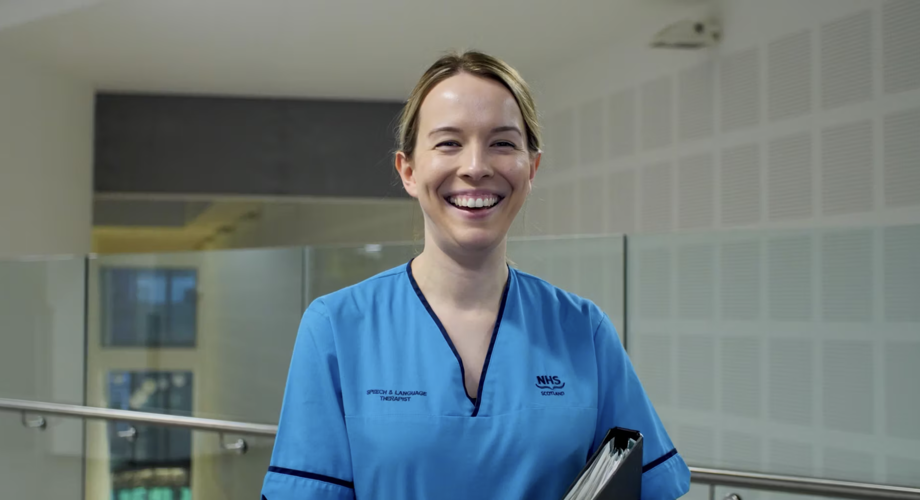06 March 2024
•6 min read

Who is Claire?
Claire is an advanced speech and language therapist with over 10 years of professional experience. She works in NHSScotland with adult patients who have neurological conditions, brain tumours, brain injuries, or those who have experienced major trauma due to an accident.
Straight from school, Claire went to Queen Margaret University, where she graduated with a BSc (Hons) in Speech and Language Therapy.
Starting out as a newly qualified speech and language therapist
Claire’s first job was in England where she worked in many clinical settings, including acute hospital, rehab unit, and in the community. She also gained experience in different areas, such as stroke, medicine of the elderly, and general medical wards.
During this time, Claire discovered her passion for all things brain-related and started working at the Walton Centre of Neurology and Neurosurgery. Here, Claire was able to advance her skills in this area.
Specialising in neurological conditions
After returning to Edinburgh, Claire started working in a community service for progressive neurological conditions at NHS Lothian. She enjoyed working closely with a team of multidisciplinary professionals.
Claire leads the SLT team in the neurosurgical, neurology, and major trauma centre wards in the Department of Clinical Neurosciences at the Royal Hospital in Edinburgh.
Claire shared that what she loves most about her job is advocating for patients and their families and building a strong rapport with them. Her clinical interests include:
- cognitive communication disorders
- disorders of consciousness
- awake craniotomy
Additionally, she actively promotes wellbeing and supervision within her team.
Royal College of Speech and Language Therapists
Claire is a member of the Royal College of Speech and Language Therapists Hub Forum Scotland committee. She is an ambassador for her profession and works to raise awareness about the important work that speech and language therapists do across the country.
Claire’s career journey in speech and language therapy
In this video, Claire describes her career journey to becoming a qualified speech and language therapist. She also explains what motivated her to choose this profession.
Claire highlights some of the skills needed to be a speech and language therapist. It could be your ideal career if you’re caring, compassionate, creative, and enjoy using technology.
How to watch our 360 videos
To navigate the 360 videos on this page, follow these instructions:
- If you are using a mouse, hold the left or right button to move the cursor around the screen. Move the cursor to the left to turn left, and to the right to turn right, and so on.
- If you are using a laptop trackpad, click and hold anywhere on the trackpad, then use your finger to move the cursor around the screen. Move your finger to the left to turn left, and to the right to turn right, and so on.
- If you are using a mobile, press and hold the screen while moving your finger. Move your finger to the left to turn left, and to the right to turn right, and so on.
To get the full AHP VR experience, download our immersive video files to your headset.
Scene one video: Eye-gaze device
Claire, a speech and language therapist, introduces and describes the function of an eye-gaze device to Rachel, the patient. She then assesses Rachel's ability to use the device by giving her tasks to complete interacting with the device.
This is an example of a high-tech alternative and augmentative communication device. It can be used by someone when they can no longer use their voice.
The eye-gaze device uses infrared technology to track your eye movements when you look at the screen. It allows someone to spell out words or select pre-saved information to then be read out loud by the device. You can also use this device to connect to social media and home technologies to increase the user’s independence.
Scene two video: assessing communication difficulties
Claire assesses Rachel's ability to name and retrieve these words from her brain. She does this by showing Rachel pictures of everyday objects.
When Rachel struggles to retrieve the word, Claire then gives her 2 different types of clues:
- "semantic" - a description cue
- "phonemic" - a sound cue
Claire can then determine where the level of communication breakdown occurs in Rachel's language production and what strategies will help her. Claire will then prescribe a treatment plan specifically for Rachel. It will help her to speak with fewer difficulties.
Scene three video: improving swallowing function
Claire introduces exercises that will help to strengthen the muscles involved in Rachel's swallow function. They will also help improve the efficiency and safety of her swallow.
If someone's swallow function is impaired, it can result in the following:
- choking
- food or fluids entering the lungs
- a chest infection making the person feel unwell
Speech and language therapists have specialist skills and knowledge to assess someone's swallow and prescribe a targeted treatment rehabilitation programme.
You can become a speech and language therapist like Claire
As a speech and language therapist, you’ll help people with communication difficulties and eating, drinking, and swallowing problems. You can specialise in working with specific patient groups or in different parts of the service.
Using different exercises, techniques, and technologies, you’ll assess a person’s communication or swallowing ability. You’ll then create and implement therapy programmes and work with them to monitor progress.
Find out how you can become a speech and language therapist.

Discover more allied health professions
Explore our 360 videos and interviews that introduce other allied health professions (AHPs).